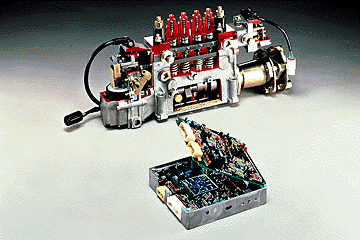
 Mitsubishi's CFC Report Eliminating CFCs: An Urgent Task
Mitsubishi's CFC Report Eliminating CFCs: An Urgent TaskIn November 1992, the Montreal Protocol on ozone layer destruction was strengthened, calling for the complete elimination of specific CFCs by the year 1996, as well as the restriction of other substances like 1,1,1-trichloroethane.As soon as CFCs were identified as a major cause of ozone layer destruction, Mitsubishi began an urgent phase-out program. Now, under the guidance of the Environmental Council, Mitsubishi stepped up its schedule and completely eliminate CFCs in 1994, well ahead of all international agreements.
Mitsubishi has already eliminated the use of CFCs in cleaning and production. The elimination of CFCs from car air conditioning systems is well underway.
The Environmental Council is also concerned about CFCs that have already been produced and are being used in air conditioning systems of cars currently on the road. Mitsubishi has developed a system of both education and technological support to keep those CFCs from being released into the atmosphere.

 Status of Specific CFCs Used at Mitsubishi
Status of Specific CFCs Used at MitsubishiMitsubishi Motors has been phasing out all CFCs as quickly as possible. CFC-11, CFC-12, and CFC-113 have already been eliminated, and Mitsubishi Motors expects to eliminate CFC-12 in 1994.
|
CFC-11 (Foaming Agent for production process) Eliminated in 1993 | |
|---|---|
| Uses | Replacement |
| Seat | Water Foaming |
| Bumper | Air and/or *HCFC-123 |
| Steering Wheel | HCFC-22 or -123 |
| Rear Spoiler | HCFC-22 or -123 |
|
CFC-12 (Refrigerant for air conditioners) Eliminated in 1994 | |
| Air Conditioner (New Models) |
*HFC-134a (from 1992) |
| Air Conditioner (Established Models) |
20% reduced CFC-12 system, adopted in 1990 for use until total phase-out in 1994 |
| Air Conditioner (Vehicles on the road) |
Retrieval and Regeneration Units dispatched to
service centersaround the world Retrofit conversion kits (CFC-12 to HFC-134a) available from 1994 |
|
CFC-113 (Cleaning Solvent) Eliminated in 1990 | |
| Intake Manifold | Hot water and centrifuge |
| Gears | Ultrasonic |

 Slowing Global Warming By Using Less Fuel
Slowing Global Warming By Using Less FuelUnlike the situation with CFCs, industry cannot eliminate the production of greenhouse gases. As long as we are dependent on fossil fuels, CO2 emissions are unavoidable. But we can diminish the impact of global warming by reducing CO2 emissions as much as possible, especially by limiting the use of fossil fuels. The logic is simple: use less fuel, produce less CO2. This makes fuel-efficient cars a necessity.Mitsubishi has constantly worked to improve engine and drivetrain efficiency and to reduce aerodynamic and rolling resistance. Many years of research in this area have given Mitsubishi a reputation as a world leader in the drive to reduce fuel consumption. The result has been fuel efficiency even better than that stipulated by the strict standards of the Japanese government.
In addition, Mitsubishi has devoted years of research to developing vehicles that run on alternative fuel sources in pursuit of viable alternative fuel vehicles that emit significantly less CO2.
Mitsubishi's goal is to reduce greenhouse gases to the bare minimum, so that global warming can be curtailed. The Environmental Council has pledged to continue that commitment to research and application.
| Unnecessary Activity | Waste |
|---|---|
| 10 sudden accelerations | 50 cc |
| 10 sudden starts | 100 cc |
| Extra 10 kg load for 50 km | 50 cc |
| Engine revving 10 times | 50 cc |
| 10 minutes driving | 500 cc |
| 10 minutes idling | 200 cc |

 Fighting Acid Rain By Reducing NOx and SOx
Fighting Acid Rain By Reducing NOx and SOxTo prevent damage to lakes, forests and cities from acid rain, SOx and NOx emissions must be reduced. In conventional petrol engines, NOx has been dramatically reduced by the use of three-way catalytic converters, and SOx emissions are usually not a problem. Exhaust emissions from diesel engines are the main problem.SOx has been reduced by lowering the sulfur content of diesel fuel. An international goal has been set to cut the level from its current 0.2% to 0.05% by 1997.
Reducing NOx is a more complicated problem. It's very difficult to decrease NOx emissions without increasing harmful emissions of another kind. Lowering the combustion temperature reduces NOx, but it also decreases combustion efficiency, which results in increased particulate matter, carbon monoxide and hydrocarbon emissions.
Mitsubishi has recently made some engineering advances toward reducing NOx emissions from diesel engines without causing other problems. The Environmental Council is over-seeing research on new types of catalytic converters for diesel and lean-burn engines.
In addition, Mitsubishi continues to research alternative power source vehicles, some of which emit little or no NOx and SOx. Mitsubishi hopes this research leads to an alternative fuel-source vehicle that does not contribute to acid rain.

 Pre-Stroke Control Type Fuel Injection Pump
Pre-Stroke Control Type Fuel Injection Pump

The timing of fuel infection directly affects the combustion temperature, and thus the amount of NOx produced. If fuel injection is delayed, the combustion temperature is lowered and less NOx is produced. However, more particulate matter is emitted. To solve this problem, Mitsubishi worked with Zexel to develop the innovative Pre-Stroke Control Fuel Injection Pump. This pump raises the fuel injection pressure at low engine speed. This pump allows a reduction in NOx emissions without a significant increase in the amount of particulate matter emitted.

 Exhaust Gas Recirculation System
Exhaust Gas Recirculation SystemThis system recirculates the exhaust gas to reduce the NOx emissions of petrol engines. However, with diesel engines, it causes problems. Soot and sulfur in the recirculated exhaust gas wear out the piston rings and liners. Mitsubishi is working on ways to adapt this system for diesel engines.

NEXT TOPIC: "Preparing Cars for Tomorrow's Reuse"

![]() Copyright 1995 by Mitsubishi Motors Corporation.
Copyright 1995 by Mitsubishi Motors Corporation.